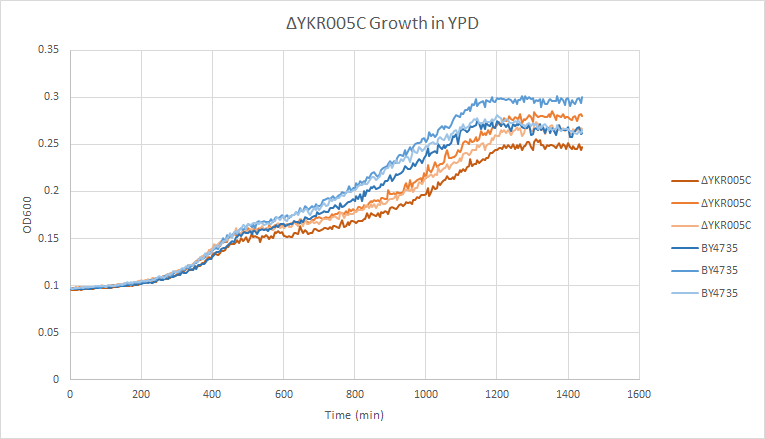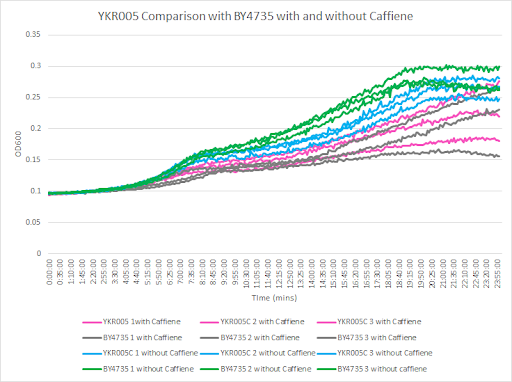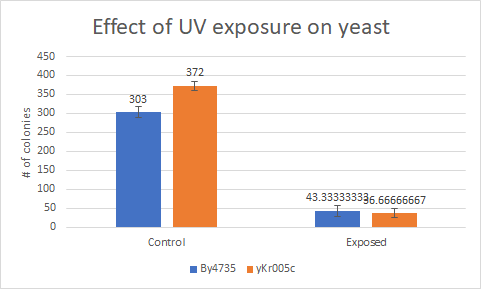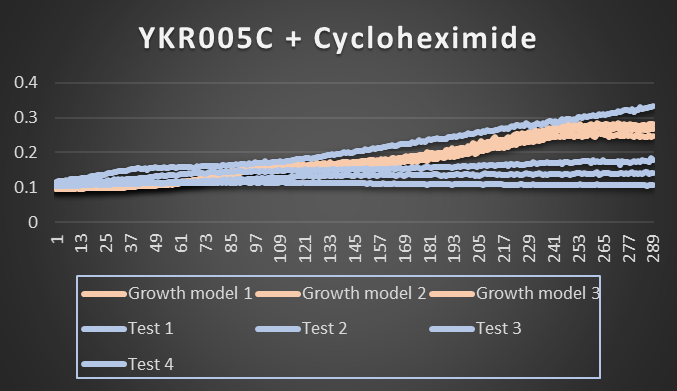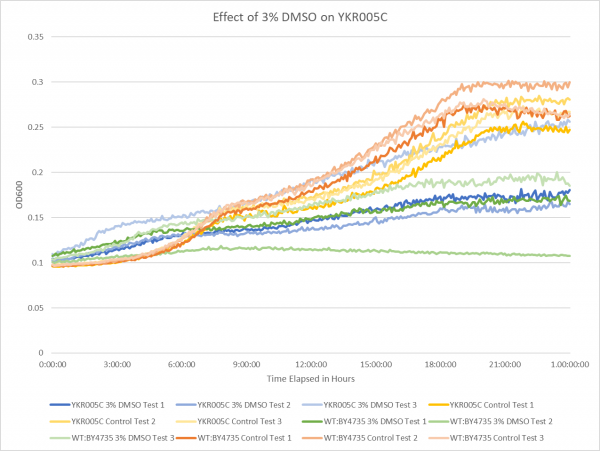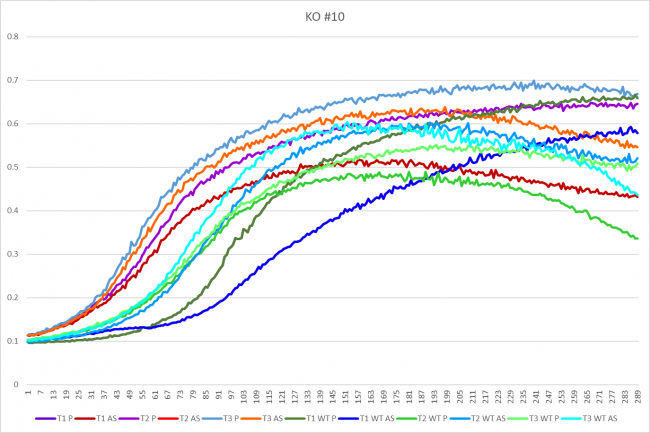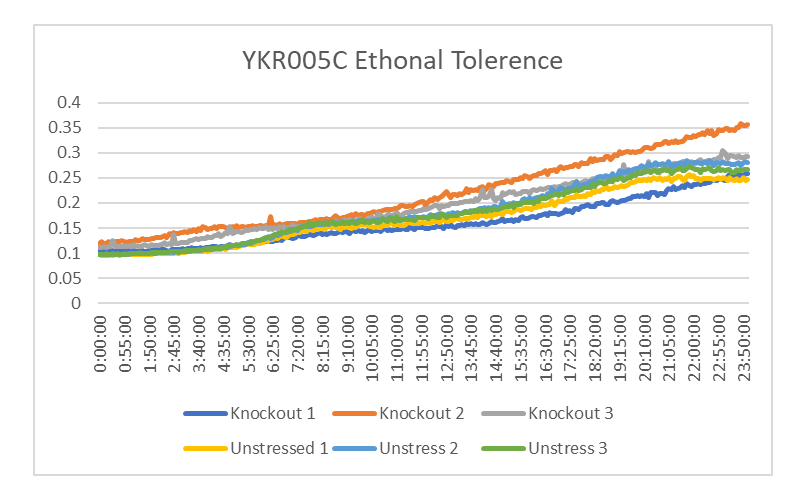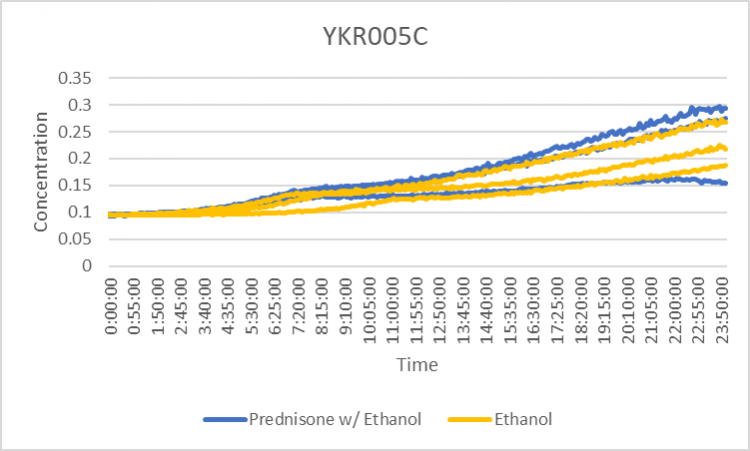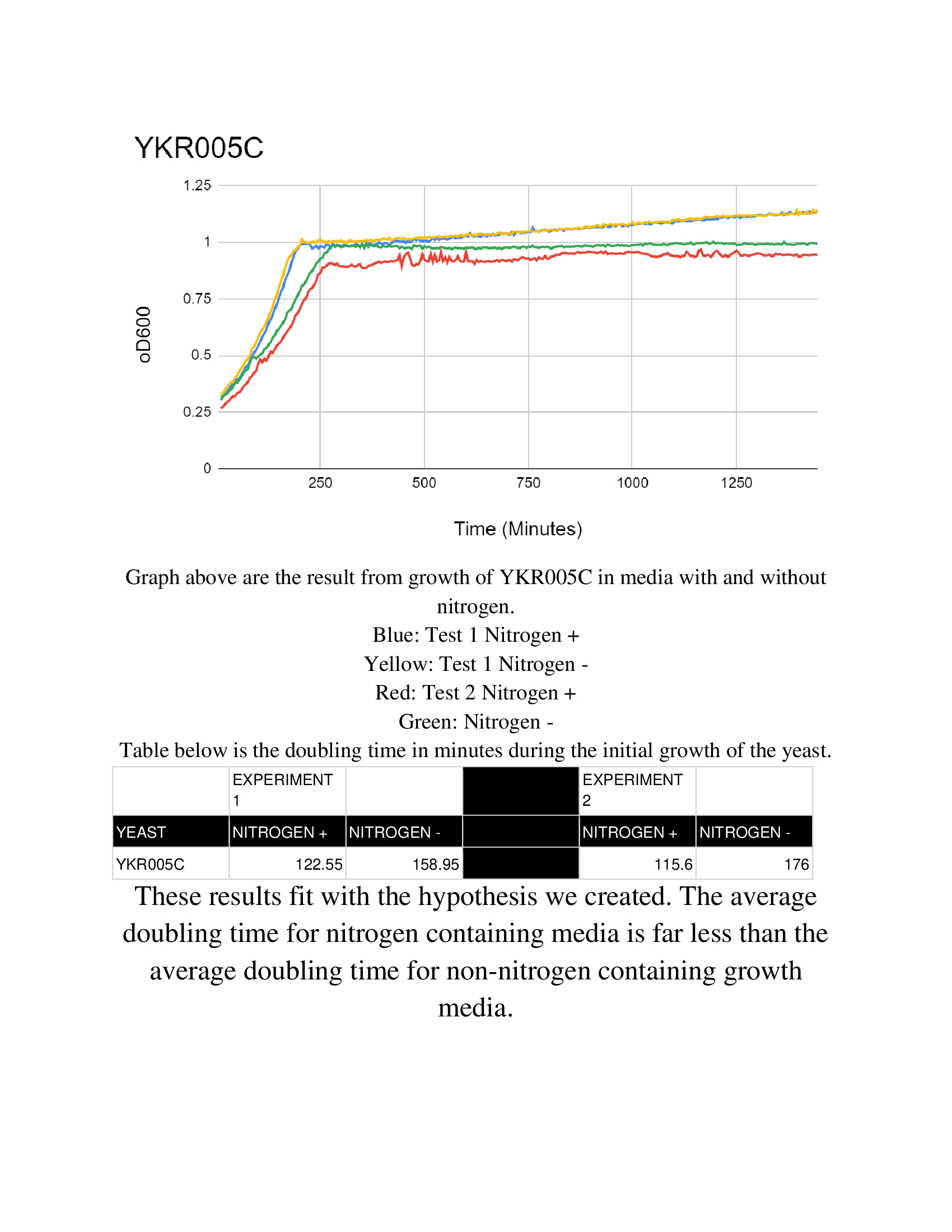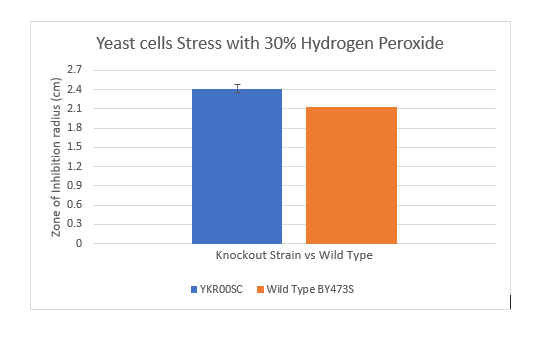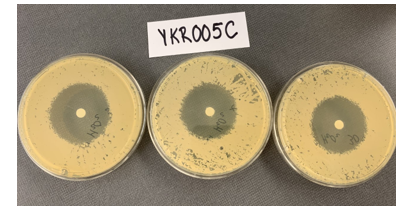Difference between revisions of "YKR005C"
(→Prednisone Effects on YKR005C) |
|||
| (18 intermediate revisions by the same user not shown) | |||
| Line 67: | Line 67: | ||
The graph above shows the effect of 3% DMSO on YKR005C. While examining the data from test 3 it is thought that the 3% DMSO test on YKR005C was contaminated; the results are still shown on the graph but the information was not used during growth rate calculations. From the data represented the average doubling rate for the YKR005C knockout strain without DMSO was 519 minutes. When DMSO is added the average doubling time increased to 1490 minutes. This shows that 3% DMSO did add stress to this knockout strain. The average doubling time of WT:BY4735 without DMSO was 514 minutes. The average doubling rate for WT:BY4735 with DMSO was 1529 minutes. If we compare the average doubling rate of WT:BY4735 with DMSO to YKR005C with DMSO we see the yeast grew at about the same rate under DMSO induced stress which means that the YKR005C had very minimal effects on growth rate under stress. It is also observed that both control groups had a growth rate within 5 minutes of each other, which means that the YKR005C gene has no effect of yeast growth in optimal conditions. | The graph above shows the effect of 3% DMSO on YKR005C. While examining the data from test 3 it is thought that the 3% DMSO test on YKR005C was contaminated; the results are still shown on the graph but the information was not used during growth rate calculations. From the data represented the average doubling rate for the YKR005C knockout strain without DMSO was 519 minutes. When DMSO is added the average doubling time increased to 1490 minutes. This shows that 3% DMSO did add stress to this knockout strain. The average doubling time of WT:BY4735 without DMSO was 514 minutes. The average doubling rate for WT:BY4735 with DMSO was 1529 minutes. If we compare the average doubling rate of WT:BY4735 with DMSO to YKR005C with DMSO we see the yeast grew at about the same rate under DMSO induced stress which means that the YKR005C had very minimal effects on growth rate under stress. It is also observed that both control groups had a growth rate within 5 minutes of each other, which means that the YKR005C gene has no effect of yeast growth in optimal conditions. | ||
| + | |||
| + | |||
| + | ===[[UW Stout/Proline FA19|Growth in Proline and Ammonium Sulfate]]=== | ||
| + | |||
| + | [[File:KO10.png|650 px]] | ||
| + | |||
| + | |||
| + | In Tests 1-3 in proline media, the average doubling rate was 36.77 minutes. In Tests 1-3 in ammonium sulfate media, the average doubling rate was 44.1 minutes. So comparing YKR005C in proline media to ammonium sulfate media, the proline media grew faster. This is the same in the wild types growing in both medias. The average doubling rates were 40.67 minutes in proline media and 72.00 minutes in ammonium sulfate media. This strand is interesting because it appears to grow faster in proline than ammonium sulfate. | ||
==Ethanol Tolerance in YKR005C== | ==Ethanol Tolerance in YKR005C== | ||
[[Image:YKR005C_ethonal.png]] | [[Image:YKR005C_ethonal.png]] | ||
| − | This graph shows the growth between YKR005C treated and untreated with ethanol. The rate of growth of the yeast treated with ethanol is | + | This graph shows the growth between YKR005C treated and untreated with ethanol. The rate of growth of the yeast treated with ethanol is 1013.33 minutes. The rate of growth of the yeast not treated with ethanol is 2089.59 minutes. This shows that the strands of YKR005C treated with ethanol had a decrease growth rate compared to those that weren't. |
===[[UW-Stout/Prednisone_FA19|Prednisone Effects on YKR005C]]=== | ===[[UW-Stout/Prednisone_FA19|Prednisone Effects on YKR005C]]=== | ||
| Line 78: | Line 86: | ||
The graph above shows how dilutions P2 (30 µg/ml) and E2 (10% ethanol solution) impacted the growth rate of the knockout yeast strain YKR005C over 24 hours. The concentration did not double for test 3 of P2 for this experiment, so by taking only the first two test results, the doubling rate averages to around 1182.5 minutes for only ethanol. As for the Prednisone with ethanol, the doubling rate averages to around 990 minutes. Overall, the Prednisone decreased the rate of growth by almost 193 minutes. These results conclude that Prednisone promotes the growth of yeast cells without the YKR005C gene. | The graph above shows how dilutions P2 (30 µg/ml) and E2 (10% ethanol solution) impacted the growth rate of the knockout yeast strain YKR005C over 24 hours. The concentration did not double for test 3 of P2 for this experiment, so by taking only the first two test results, the doubling rate averages to around 1182.5 minutes for only ethanol. As for the Prednisone with ethanol, the doubling rate averages to around 990 minutes. Overall, the Prednisone decreased the rate of growth by almost 193 minutes. These results conclude that Prednisone promotes the growth of yeast cells without the YKR005C gene. | ||
| + | ===1% Formamide Yeast Torture[[https://wiki.yeastgenome.org/index.php/UW_Stout/Formamide_FA19]]=== | ||
| + | [[Image:image_10.png]] | ||
| + | |||
| + | This graph shows the growth curve of the knockout yeast strain YKR005C and wild type BY4735 in 1% formamide in 3 trials. The average calculated doubling time for YKR005C with 1% formamide was 3,669.97 minutes, while the unstressed strain was 2,313.44 minutes. This concluded that the unstressed strain is not sensitive to 1% formamide, and grows at a faster pace in this environment. Our stressed wild type's doubling time was 2,978.81 minutes, and the unstressed was 2,234.29 minutes. Proving that the addition of 1% formamide to the stressed wild type makes it more sensitive to it's surroundings and leads to slower growth. | ||
| + | |||
| + | [[File:Nitrogen_Starvation_YKR005C.jpg|463 x 599|Caption]] | ||
| + | |||
| + | The Wild Type BY4735 has data located at the Nitrogen Starvation Protocol. | ||
| + | ==[[UW-Stout/Nitrogen_starvation_FA19|Nitrogen starvation]]== | ||
| + | |||
| + | == [https://wiki.yeastgenome.org/index.php?title=UW-Stout/Hydroxyurea_FA19&oldid=401696 Hydroxyurea] == | ||
| + | [[File:AvaYKR005C.png]] | ||
| + | The averaging doubling time for YKR005C is 636.85 minutes. The averaging doubling time for the unstressed YKR005C is 413.18 minutes | ||
<!-- PLEASE ADD Community Commentary ABOVE THIS MESSAGE. See below for an example of community annotation --> | <!-- PLEASE ADD Community Commentary ABOVE THIS MESSAGE. See below for an example of community annotation --> | ||
| Line 86: | Line 107: | ||
--> | --> | ||
| + | ===Zone of Inhibition of 30% [https://wiki.yeastgenome.org/index.php/UW-Stout/Hydrogen_peroxide_FA19 Hydrogen Peroxide] on YKR005C=== | ||
| + | [[File:JJ1.PNG]] | ||
| + | [[File:JaredJ1.PNG]] | ||
| + | The bar graph represents the zone of inhibition of the knockout strain versus the wild type. Our data collected shows that the knockout strain saw a larger zone of inhibition (cells were not able to grow there) than the wild type by an increment of 0.3cm. The error bar on the knockout strain represents the standard deviation of the experiment and how recreatable our results were with these results. Using these observations it is evident that the yeast strain YKR005C undergoes more stress from the oxidative properties of 30 percent hydrogen peroxide. The zone of inhibition is larger because the yeast cells are not able to grow as well as the wild type can in these conditions. For the strain YKR005C our plate values were as follows (in cm) 2.5, 2.4 and 2.35 compared to our wild type plate which stayed constant 2.1, 2.1 and 2.2 cm | ||
<protect> | <protect> | ||
Latest revision as of 00:54, 18 December 2019
Share your knowledge...Edit this entry! <protect>
| Systematic name | YKR005C |
| Gene name | |
| Aliases | |
| Feature type | ORF, Uncharacterized |
| Coordinates | Chr XI:450167..448521 |
| Primary SGDID | S000001713 |
Description of YKR005C: Putative protein of unknown function[1]
</protect>
Contents
Community Commentary
About Community Commentary. Please share your knowledge!
This gene is part of the UW-Stout Orphan Gene Project. Learn more here.
Growth in YPD
In a BY4735 background, knocking out YKR005C seems to have a little to no effect on growth rate in log-phase. In this assay, the BY4735 strain's doubling time was 414 minutes, while the YKR005C knock-out strain's doubling time was 427 minutes. (These doubling times are the means of three experiments.)
Caffeine and Yeast Cells
This graph shows the growth curve with and without caffeine. It has the knockout strain and wild type yeast cells. The caffeine enhanced the growth in both wild type and knockout strain. The average doubling time between the three experiments for the knockout strand was 736.38 minutes. The caffeine also had a positive effect on the growth curve for the wild type with the average doubling time being 1245.02 minutes. The results were concluded from the wild type and knockout strand was with this amount of caffeine it leads to an increase in growth.
The protocol can be found at
Caffeine
This bar graph shows that compared to a BY4735 background, Knocking out yKR005c makes yeast a little more sensitive to UV light.
the protocol can be found at
UV Light Exposure
Cycloheximide effects on YKR005C
As we can see from the image above Tests 1-3 are below the growth curve and did not function as well. Test 4 is above which is weird. The growth curve is made up of the growth curve models 1-3 which are not being stressed.
Effect of 3% DMSO on YKR005C
The graph above shows the effect of 3% DMSO on YKR005C. While examining the data from test 3 it is thought that the 3% DMSO test on YKR005C was contaminated; the results are still shown on the graph but the information was not used during growth rate calculations. From the data represented the average doubling rate for the YKR005C knockout strain without DMSO was 519 minutes. When DMSO is added the average doubling time increased to 1490 minutes. This shows that 3% DMSO did add stress to this knockout strain. The average doubling time of WT:BY4735 without DMSO was 514 minutes. The average doubling rate for WT:BY4735 with DMSO was 1529 minutes. If we compare the average doubling rate of WT:BY4735 with DMSO to YKR005C with DMSO we see the yeast grew at about the same rate under DMSO induced stress which means that the YKR005C had very minimal effects on growth rate under stress. It is also observed that both control groups had a growth rate within 5 minutes of each other, which means that the YKR005C gene has no effect of yeast growth in optimal conditions.
Growth in Proline and Ammonium Sulfate
In Tests 1-3 in proline media, the average doubling rate was 36.77 minutes. In Tests 1-3 in ammonium sulfate media, the average doubling rate was 44.1 minutes. So comparing YKR005C in proline media to ammonium sulfate media, the proline media grew faster. This is the same in the wild types growing in both medias. The average doubling rates were 40.67 minutes in proline media and 72.00 minutes in ammonium sulfate media. This strand is interesting because it appears to grow faster in proline than ammonium sulfate.
Ethanol Tolerance in YKR005C
This graph shows the growth between YKR005C treated and untreated with ethanol. The rate of growth of the yeast treated with ethanol is 1013.33 minutes. The rate of growth of the yeast not treated with ethanol is 2089.59 minutes. This shows that the strands of YKR005C treated with ethanol had a decrease growth rate compared to those that weren't.
Prednisone Effects on YKR005C
The graph above shows how dilutions P2 (30 µg/ml) and E2 (10% ethanol solution) impacted the growth rate of the knockout yeast strain YKR005C over 24 hours. The concentration did not double for test 3 of P2 for this experiment, so by taking only the first two test results, the doubling rate averages to around 1182.5 minutes for only ethanol. As for the Prednisone with ethanol, the doubling rate averages to around 990 minutes. Overall, the Prednisone decreased the rate of growth by almost 193 minutes. These results conclude that Prednisone promotes the growth of yeast cells without the YKR005C gene.
1% Formamide Yeast Torture[[1]]
This graph shows the growth curve of the knockout yeast strain YKR005C and wild type BY4735 in 1% formamide in 3 trials. The average calculated doubling time for YKR005C with 1% formamide was 3,669.97 minutes, while the unstressed strain was 2,313.44 minutes. This concluded that the unstressed strain is not sensitive to 1% formamide, and grows at a faster pace in this environment. Our stressed wild type's doubling time was 2,978.81 minutes, and the unstressed was 2,234.29 minutes. Proving that the addition of 1% formamide to the stressed wild type makes it more sensitive to it's surroundings and leads to slower growth.
The Wild Type BY4735 has data located at the Nitrogen Starvation Protocol.
Nitrogen starvation
Hydroxyurea
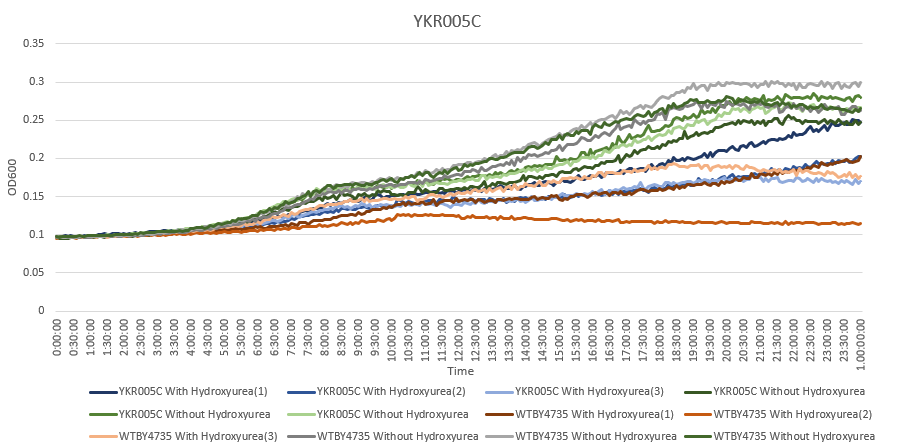 The averaging doubling time for YKR005C is 636.85 minutes. The averaging doubling time for the unstressed YKR005C is 413.18 minutes
The averaging doubling time for YKR005C is 636.85 minutes. The averaging doubling time for the unstressed YKR005C is 413.18 minutes
Zone of Inhibition of 30% Hydrogen Peroxide on YKR005C
The bar graph represents the zone of inhibition of the knockout strain versus the wild type. Our data collected shows that the knockout strain saw a larger zone of inhibition (cells were not able to grow there) than the wild type by an increment of 0.3cm. The error bar on the knockout strain represents the standard deviation of the experiment and how recreatable our results were with these results. Using these observations it is evident that the yeast strain YKR005C undergoes more stress from the oxidative properties of 30 percent hydrogen peroxide. The zone of inhibition is larger because the yeast cells are not able to grow as well as the wild type can in these conditions. For the strain YKR005C our plate values were as follows (in cm) 2.5, 2.4 and 2.35 compared to our wild type plate which stayed constant 2.1, 2.1 and 2.2 cm
<protect>
References
See Help:References on how to add references
See Help:Categories on how to add the wiki page for this gene to a Category </protect>
